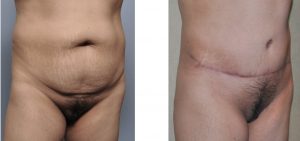
The most common complication after any form of a tummy tuck is a fluid build-up or a seroma. Most tummy tucks use drains for a period of time after surgery. While newer techniques are being developed that can either decrease the time a drain is in or perhaps eliminate it completely, most plastic surgeons still use drains. The risk of a seroma build-up occurs after the drain is removed. This occurs because the body is still weeping fluid inside from the unhealed raw surfaces and it is too much to be absorbed. Such fluid build-up is ‘promoted’ by too much activity in the first few weeks after the drain is removed. Not getting too active too early and wearing your circumferential binder (which helps push the underside of the skin flap which heals it to heal back together)as much as possible are two things a patient can do to help prevent the development of a seroma.
The other more significant complication is healing problems of the incision which could be as extensive as skin necrosis and opening of portions of the healing incision. This is a real risk in patients who smoke. Even smoking just a ‘cigarette or two a day’ can cause this problem. It is extremely important to stop smoking three weeks before surgery and at least three weeks after. This is necessary to clear out and keep out any agents, such as nicotine and carbon monoxide, which cause vasoconstriction and impair the delivery of oxygen to healing tissues that are starving for it. If you smoke and can not absolutely adhere to these guidelines, you should not have a tummy tuck.
2. What is the difference between abdominal liposuction and a tummy tuck?
While both are surgical methods of abdominal contouring, they are substantially different and are used for anatomically different abdominal problems. Liposuction removes fat and has only a very mild effect at having skin shrink or contract. It is best used when the overlying skin quality is good, there is no loose abdominal skin, and it is clear that the accumulation of fat is the primary problem.
Tummy tucks are excisional procedures that remove a certain amount of fat AND skin. As a result, it produces better results in the patients who has excess fat and loose or overhanging abdominal skin. It also allows for the central abdominal muscles to be tightened. Treating all three anatomic problems is a more extensive surgery but it also results in a better and flatter abdominal result. Often times, liposuction is also used particularly at the sides of the waistline and into the back area to create more of a near circumferential result.
3. What is the difference between a mini- and a full tummy tuck?
Conceptually, the difference between the two relates to how much skin is removed and where. A mini-tummy tuck is a more limited operation and removes skin and fat from below the belly button. This keeps the final scar well inside the front bony edges of the hips. A full tummy tuck removes skin and fat going above the belly button. This creates a longer horizontal scar that goes from one hip to the other. This also creates a scar around the belly button as it is re-created in a position on the pulled down abdominal skin.
Choosing between a mini- and a full tummy tuck is determined by how much excess skin you have and how long of a scar you can tolerate.
4. How painful is a tummy tuck?
Certainly, tummy tucks are not pain-free. But they are not excruciatingly painful either. Most of the discomfort comes from the manipulation of the muscle. If this is not done, and s it is not done in every tummy tuck, then it can be more comfortable than you thought. But when muscle manipulation is done, it creates a feeling of tightness and difficulty in standing up straight in some cases It takes a few days to adjust to this feeling at which point it becomes more tolerable. And yes…pain medications are provided and necessary.
5. How bad is the scar from a tummy tuck?
The vast majority of tummy tuck scars look quite good. Despite the fact that the incision is closed under tension, which can be a real cause of scar widening, the orientation of a tummy tuck scar accounts for much of its good long-term outcome. The low horizontal lie of the scar places it parallel to the relaxed skin tension lines (RSTL) of the body which are circumferential in the trunk. It is well known that scars that run parallel to the RSTLs produce better scars than those that are perpendicular or run obliquely to it.
The techniques that plastic surgeons use also contribute to more narrow scars. One of the more recent methods is the use of internal barbed sutures that hold the incision together underneath the skin for a long period of time before it resorbs.
6. Can I have children after having had a tummy tuck?
While I would advise that one should wait until they are done having children (so that the result is not partially or completely lost), I have known more than a few patients who have gotten pregnant after tummy tuck surgery. Because pregnancy is a slow expansion process, the scar and muscle tightening from a tummy tuck is gradually stretched out without a problem.
7. Are tummy tucks covered by insurance?
Unfortunately, no. Unless one has a very large pannus (skin overhang onto the thighs), the abdominal concern is not viewed as a medical problem. In days long gone by, the separated muscles (rectus diastasis) was used as a medical reason for coverage. But the muscle problem is no longer viewed as causing medical symptoms worthy of health insurance coverage unless there is a hernia associated with it.
Dr. Barry Eppley
Indianapolis, Indiana


